Vipul Gupta
HRScene: How Far Are VLMs from Effective High-Resolution Image Understanding?
Apr 29, 2025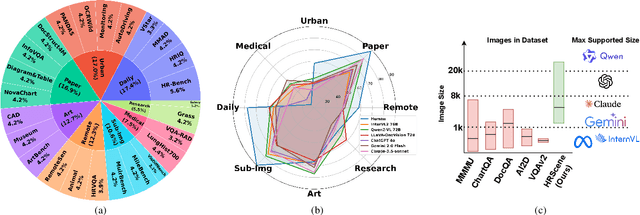
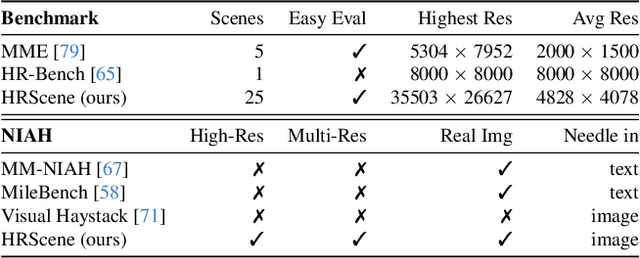
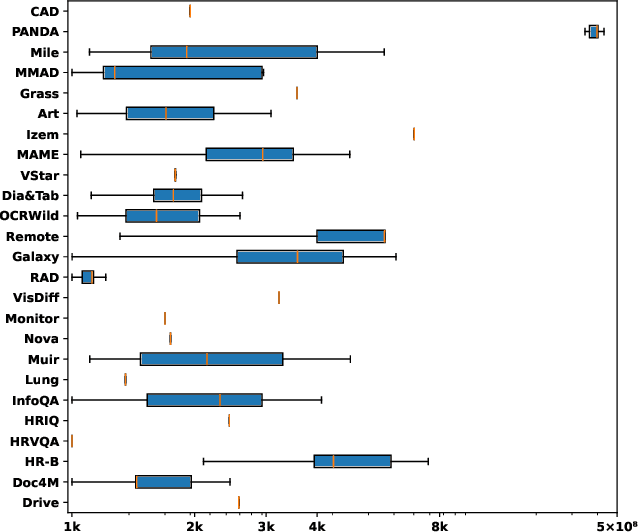

Abstract:High-resolution image (HRI) understanding aims to process images with a large number of pixels, such as pathological images and agricultural aerial images, both of which can exceed 1 million pixels. Vision Large Language Models (VLMs) can allegedly handle HRIs, however, there is a lack of a comprehensive benchmark for VLMs to evaluate HRI understanding. To address this gap, we introduce HRScene, a novel unified benchmark for HRI understanding with rich scenes. HRScene incorporates 25 real-world datasets and 2 synthetic diagnostic datasets with resolutions ranging from 1,024 $\times$ 1,024 to 35,503 $\times$ 26,627. HRScene is collected and re-annotated by 10 graduate-level annotators, covering 25 scenarios, ranging from microscopic to radiology images, street views, long-range pictures, and telescope images. It includes HRIs of real-world objects, scanned documents, and composite multi-image. The two diagnostic evaluation datasets are synthesized by combining the target image with the gold answer and distracting images in different orders, assessing how well models utilize regions in HRI. We conduct extensive experiments involving 28 VLMs, including Gemini 2.0 Flash and GPT-4o. Experiments on HRScene show that current VLMs achieve an average accuracy of around 50% on real-world tasks, revealing significant gaps in HRI understanding. Results on synthetic datasets reveal that VLMs struggle to effectively utilize HRI regions, showing significant Regional Divergence and lost-in-middle, shedding light on future research.
Attention Pruning: Automated Fairness Repair of Language Models via Surrogate Simulated Annealing
Mar 20, 2025Abstract:This paper explores pruning attention heads as a post-processing bias mitigation method for large language models (LLMs). Modern AI systems such as LLMs are expanding into sensitive social contexts where fairness concerns become especially crucial. Since LLMs develop decision-making patterns by training on massive datasets of human-generated content, they naturally encode and perpetuate societal biases. While modifying training datasets and algorithms is expensive and requires significant resources; post-processing techniques-such as selectively deactivating neurons and attention heads in pre-trained LLMs-can provide feasible and effective approaches to improve fairness. However, identifying the optimal subset of parameters to prune presents a combinatorial challenge within LLMs' immense parameter space, requiring solutions that efficiently balance competing objectives across the frontiers of model fairness and utility. To address the computational challenges, we explore a search-based program repair approach via randomized simulated annealing. Given the prohibitive evaluation costs in billion-parameter LLMs, we develop surrogate deep neural networks that efficiently model the relationship between attention head states (active/inactive) and their corresponding fairness/utility metrics. This allows us to perform optimization over the surrogate models and efficiently identify optimal subsets of attention heads for selective pruning rather than directly searching through the LLM parameter space. This paper introduces Attention Pruning, a fairness-aware surrogate simulated annealing approach to prune attention heads in LLMs that disproportionately contribute to bias while minimally impacting overall model utility. Our experiments show that Attention Pruning achieves up to $40\%$ reduction in gender bias and outperforms the state-of-the-art bias mitigation strategies.
Improving Consistency in Large Language Models through Chain of Guidance
Feb 21, 2025Abstract:Consistency is a fundamental dimension of trustworthiness in Large Language Models (LLMs). For humans to be able to trust LLM-based applications, their outputs should be consistent when prompted with inputs that carry the same meaning or intent. Despite this need, there is no known mechanism to control and guide LLMs to be more consistent at inference time. In this paper, we introduce a novel alignment strategy to maximize semantic consistency in LLM outputs. Our proposal is based on Chain of Guidance (CoG), a multistep prompting technique that generates highly consistent outputs from LLMs. For closed-book question-answering (Q&A) tasks, when compared to direct prompting, the outputs generated using CoG show improved consistency. While other approaches like template-based responses and majority voting may offer alternative paths to consistency, our work focuses on exploring the potential of guided prompting. We use synthetic data sets comprised of consistent input-output pairs to fine-tune LLMs to produce consistent and correct outputs. Our fine-tuned models are more than twice as consistent compared to base models and show strong generalization capabilities by producing consistent outputs over datasets not used in the fine-tuning process.
Can LLMs Rank the Harmfulness of Smaller LLMs? We are Not There Yet
Feb 07, 2025



Abstract:Large language models (LLMs) have become ubiquitous, thus it is important to understand their risks and limitations. Smaller LLMs can be deployed where compute resources are constrained, such as edge devices, but with different propensity to generate harmful output. Mitigation of LLM harm typically depends on annotating the harmfulness of LLM output, which is expensive to collect from humans. This work studies two questions: How do smaller LLMs rank regarding generation of harmful content? How well can larger LLMs annotate harmfulness? We prompt three small LLMs to elicit harmful content of various types, such as discriminatory language, offensive content, privacy invasion, or negative influence, and collect human rankings of their outputs. Then, we evaluate three state-of-the-art large LLMs on their ability to annotate the harmfulness of these responses. We find that the smaller models differ with respect to harmfulness. We also find that large LLMs show low to moderate agreement with humans. These findings underline the need for further work on harm mitigation in LLMs.
Bridging the Data Provenance Gap Across Text, Speech and Video
Dec 19, 2024



Abstract:Progress in AI is driven largely by the scale and quality of training data. Despite this, there is a deficit of empirical analysis examining the attributes of well-established datasets beyond text. In this work we conduct the largest and first-of-its-kind longitudinal audit across modalities--popular text, speech, and video datasets--from their detailed sourcing trends and use restrictions to their geographical and linguistic representation. Our manual analysis covers nearly 4000 public datasets between 1990-2024, spanning 608 languages, 798 sources, 659 organizations, and 67 countries. We find that multimodal machine learning applications have overwhelmingly turned to web-crawled, synthetic, and social media platforms, such as YouTube, for their training sets, eclipsing all other sources since 2019. Secondly, tracing the chain of dataset derivations we find that while less than 33% of datasets are restrictively licensed, over 80% of the source content in widely-used text, speech, and video datasets, carry non-commercial restrictions. Finally, counter to the rising number of languages and geographies represented in public AI training datasets, our audit demonstrates measures of relative geographical and multilingual representation have failed to significantly improve their coverage since 2013. We believe the breadth of our audit enables us to empirically examine trends in data sourcing, restrictions, and Western-centricity at an ecosystem-level, and that visibility into these questions are essential to progress in responsible AI. As a contribution to ongoing improvements in dataset transparency and responsible use, we release our entire multimodal audit, allowing practitioners to trace data provenance across text, speech, and video.
Improving Model Evaluation using SMART Filtering of Benchmark Datasets
Oct 26, 2024



Abstract:One of the most challenging problems facing NLP today is evaluation. Some of the most pressing issues pertain to benchmark saturation, data contamination, and diversity in the quality of test examples. To address these concerns, we propose Selection Methodology for Accurate, Reduced, and Targeted (SMART) filtering, a novel approach to select a high-quality subset of examples from existing benchmark datasets by systematically removing less informative and less challenging examples. Our approach applies three filtering criteria, removing (i) easy examples, (ii) data-contaminated examples, and (iii) examples that are similar to each other based on distance in an embedding space. We demonstrate the effectiveness of SMART on three multiple choice QA datasets, where our methodology increases efficiency by reducing dataset size by 48\% on average, while increasing Pearson correlation with rankings from ChatBot Arena, a more open-ended human evaluation setting. Our method enables us to be more efficient, whether using SMART to make new benchmarks more challenging or to revitalize older datasets, while still preserving the relative model rankings.
Hey GPT, Can You be More Racist? Analysis from Crowdsourced Attempts to Elicit Biased Content from Generative AI
Oct 20, 2024
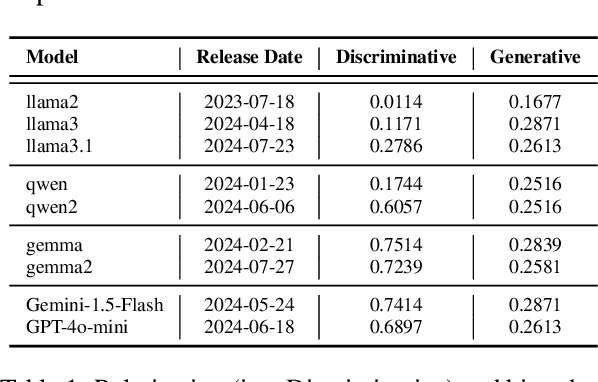

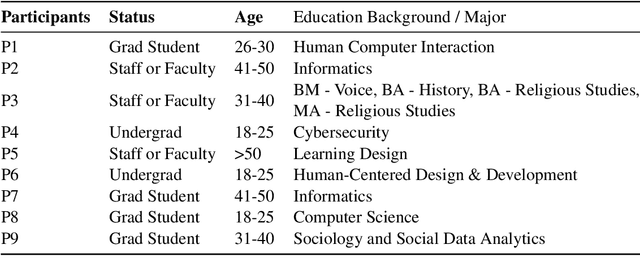
Abstract:The widespread adoption of large language models (LLMs) and generative AI (GenAI) tools across diverse applications has amplified the importance of addressing societal biases inherent within these technologies. While the NLP community has extensively studied LLM bias, research investigating how non-expert users perceive and interact with biases from these systems remains limited. As these technologies become increasingly prevalent, understanding this question is crucial to inform model developers in their efforts to mitigate bias. To address this gap, this work presents the findings from a university-level competition, which challenged participants to design prompts for eliciting biased outputs from GenAI tools. We quantitatively and qualitatively analyze the competition submissions and identify a diverse set of biases in GenAI and strategies employed by participants to induce bias in GenAI. Our finding provides unique insights into how non-expert users perceive and interact with biases from GenAI tools.
Consent in Crisis: The Rapid Decline of the AI Data Commons
Jul 24, 2024


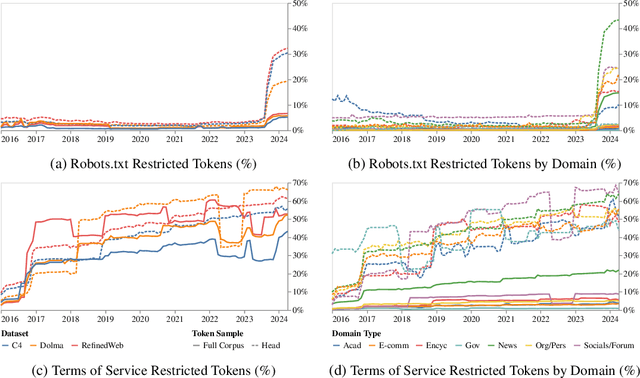
Abstract:General-purpose artificial intelligence (AI) systems are built on massive swathes of public web data, assembled into corpora such as C4, RefinedWeb, and Dolma. To our knowledge, we conduct the first, large-scale, longitudinal audit of the consent protocols for the web domains underlying AI training corpora. Our audit of 14,000 web domains provides an expansive view of crawlable web data and how codified data use preferences are changing over time. We observe a proliferation of AI-specific clauses to limit use, acute differences in restrictions on AI developers, as well as general inconsistencies between websites' expressed intentions in their Terms of Service and their robots.txt. We diagnose these as symptoms of ineffective web protocols, not designed to cope with the widespread re-purposing of the internet for AI. Our longitudinal analyses show that in a single year (2023-2024) there has been a rapid crescendo of data restrictions from web sources, rendering ~5%+ of all tokens in C4, or 28%+ of the most actively maintained, critical sources in C4, fully restricted from use. For Terms of Service crawling restrictions, a full 45% of C4 is now restricted. If respected or enforced, these restrictions are rapidly biasing the diversity, freshness, and scaling laws for general-purpose AI systems. We hope to illustrate the emerging crises in data consent, for both developers and creators. The foreclosure of much of the open web will impact not only commercial AI, but also non-commercial AI and academic research.
GraphScale: A Framework to Enable Machine Learning over Billion-node Graphs
Jul 22, 2024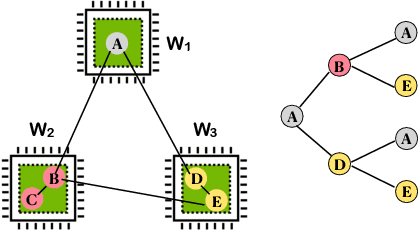
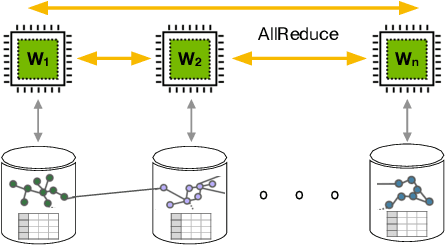
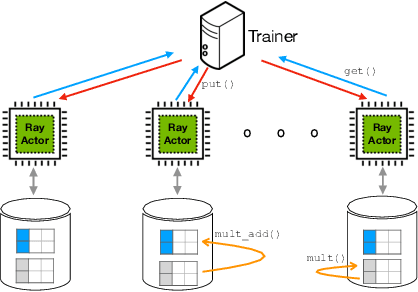
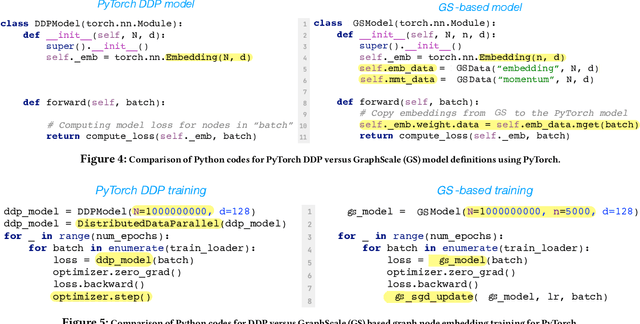
Abstract:Graph Neural Networks (GNNs) have emerged as powerful tools for supervised machine learning over graph-structured data, while sampling-based node representation learning is widely utilized in unsupervised learning. However, scalability remains a major challenge in both supervised and unsupervised learning for large graphs (e.g., those with over 1 billion nodes). The scalability bottleneck largely stems from the mini-batch sampling phase in GNNs and the random walk sampling phase in unsupervised methods. These processes often require storing features or embeddings in memory. In the context of distributed training, they require frequent, inefficient random access to data stored across different workers. Such repeated inter-worker communication for each mini-batch leads to high communication overhead and computational inefficiency. We propose GraphScale, a unified framework for both supervised and unsupervised learning to store and process large graph data distributedly. The key insight in our design is the separation of workers who store data and those who perform the training. This separation allows us to decouple computing and storage in graph training, thus effectively building a pipeline where data fetching and data computation can overlap asynchronously. Our experiments show that GraphScale outperforms state-of-the-art methods for distributed training of both GNNs and node embeddings. We evaluate GraphScale both on public and proprietary graph datasets and observe a reduction of at least 40% in end-to-end training times compared to popular distributed frameworks, without any loss in performance. While most existing methods don't support billion-node graphs for training node embeddings, GraphScale is currently deployed in production at TikTok enabling efficient learning over such large graphs.
* Published in the Proceedings of the 33rd ACM International Conference on Information and Knowledge Management (CIKM 2024), 8 Pages, 12 Figures
Changing Answer Order Can Decrease MMLU Accuracy
Jun 27, 2024



Abstract:As large language models (LLMs) have grown in prevalence, particular benchmarks have become essential for the evaluation of these models and for understanding model capabilities. Most commonly, we use test accuracy averaged across multiple subtasks in order to rank models on leaderboards, to determine which model is best for our purposes. In this paper, we investigate the robustness of the accuracy measurement on a widely used multiple choice question answering dataset, MMLU. When shuffling the answer label contents, we find that all explored models decrease in accuracy on MMLU, but not every model is equally sensitive. These findings suggest a possible adjustment to the standard practice of leaderboard testing, where we additionally consider the percentage of examples each model answers correctly by random chance.
 Add to Chrome
Add to Chrome Add to Firefox
Add to Firefox Add to Edge
Add to Edge